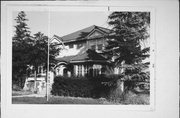| Additional Information: | WALTER TRUETTNER WAS THE BUILDER.
"This English cottage style residence with its distinctive octagonal leaded-glass bay windows was erected on land which was part of a subdivision developed by the Boulevard Park Land Company. The subdivision, whose plat received official approval from the city in 1914, was bounded by Sherman Boulevard and Wright, Clarke, and 39th Streets. While the permits fort he construction of the house do not identify its designer and builder, it is commonly attributed to William Truettner, the prominent Milwaukee architect and builder who purchased the lot in 1922. Construction of the house was completed in 1924 and Truettner and his wife Ida, who never lived in the home, sold in the same year to Alvina Hempe of Los Angeles. Like the Truettners, her ownership was brief and she did not take up residence. She rented the house from 1925 to 1928 to the woman who was destined by become its most flamboyant owner, Hulda Lewis. Lewis was the widow of Jacob Lewis, a well-known Milwaukee figure who made his living as a hotelier, liquor dealer, and real estate agent. After Lewis purchased the house in 1928, she promptly involved it in events which would culminate in lively, and very public litigation.
In 1929 Lewis used the house (which was then valued at $55,000 and subject to a $20,500 mortgage with First Wisconsin National Bank), a diamond necklace valued at $14,000, her 1928 Cadillac valued at $4,500, and personal possessions and furnishings from her house worth $12,000, as part payment for the purchase of the Colonial Hotel at Cass and Wells Streets. The deal quickly soured, as the hotel was not the money-maker Lewis thought it was. Later in 1929 the seller of the hotel, Bessie Mann joined the bank suing Lewis in foreclosure, claiming she was insolvent.
In her response to the lawsuit filed by Mann and the bank, Lewis claimed she was the victim of a conspiracy in which Mann and several "confederates...connived and conspired to obtain all of (her) possessions by...fraudulent means." According to Lewis, the scheme was one in which Mann and her "confederates" got Lewis to buy the hotel on terms they knew she could not meet so that they could foreclose and deprive her of her possessions, which Lewis contended they "coveted." Lewis maintained she was enticed into the deal by Mann's representation that a third person wanted to buy the hotel, but would not deal with Mann directly. Lewis was to buy the hotel and then sell it to the third person, a shadowy figure who never materialized, leaving Lewis the owner of the hotel with all its financial obligations.
The true nature of the dealing between Mann and Lewis likely never will be known as the lawsuit between them, whish was tracked by the local newspapers, ended in self-imposed compromise. Mann deeded the house on Sherman Boulevard back to Lewis in 1930 in settlement of the litigation between them. Back taxes and mortgage payments, among other obligations, were owed on the property, and on the day Mann deeded the house to Lewis, Lewis deeded the property to her daughter-in-law Ellen Lewis, presumably to avoid foreclosure. It didn't work. First Wisconsin foreclosed and the property was sold by sheriff's sale in 1932, about one year after Lewis' furnishings had been sold at public auction to satisfy another debt. It is easy to see why Lewis would think someone would covet her belongings: the inventory of the property from the house sold at auction is a litany of costly and fashionable antique furniture, Persian rugs, paintings, bronze lamps, and musical instruments, including a grand piano. As for Hulda Lewis, she lived until 1941, moving from apartment to apartment and making her living as a knitting instructor for Goldmann's on Mitchell Street.
Points of particular interest in this gracious residence are the sheer size of the living room; the original and never-painted woodwork throughout; the original wool carpeting, sewn together as strips rather than loomed as a whole like modern carpets; the soaring palladian window on the north facade of the house, flooding the interior staircase with light; and the terrazzo and composition marble floor in the basement, the floor plan of which mirrors the living room above." Historic Milwaukee Inc., Sherman Park Pride in Craftsmanship 13th Annual Spaces & Traces Tour Saturday, May 14, 1994, Souvenir Booklet. |
|---|

